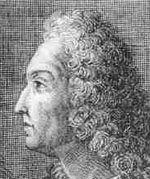Tales of Statisticians
Jacob Bernoulli
6 Jan 1655 - 16 Aug 1705
Jacob (or James, or Jacques), the son of a prosperous Protestant merchant, was the first of the remarkable Bernoulli mathematical dynasty. Back in 1583, the Bernoulli family had fled from Antwerp, first to Frankfort and then to Basel, to escape the persecutions of the Catholic Duke of Alba, acting for the absentee King of Spain. Jacob was first trained in theology, but after receiving his degree and working as a tutor in Geneva for two years, he made his own escape into mathematics. He went to France, where he studied with followers of Descartes. He visited the Netherlands, and then went to England, where he met Boyle and Hooke. On his return to Switzerland in 1683 he began teaching mechanics at the University of Basel. He published papers on algebra and probability in 1685 and on geometry in 1687, and was appointed to the chair of mathematics at Basel in 1687. At about this time his younger brother Johannes, who had been studying mechanics, asked Jacob to teach him mathematics, beginning with Leibniz's difficult 1684 paper on the calculus, the big new thing at that time. The two collaborated for a while, but a period of rivalry and mutual attacks followed, becoming even more acrimonious after Johannes moved to the Netherlands, in 1697.
Jacob's contributions to statistics include a major 1689 work on infinite series, in which his statement of the Law of Large Numbers appeared. The essence of the law is that, given an inherent probability that an event will come out a certain way, an increasing number of trials will give an increasingly accurate approximation to that frequency, random variations on either side of the inherently probable value tending to cancel out in the long run. Jacob's work on the calculus (he was the first to use the term "integral") and on geometry gave him a deep insight into the equations of many of the curves that are useful in describing growth and probability. The curve called the Lemniscate of Bernoulli still bears his name, as does the Bernoulli equation y' = p(x)y + q(x)y*n. He was so taken with another curve he investigated, the logarithmic (equilangular) spiral, that he ordered it to be engraved on his tomb with the caption Eadem mutata resurgo: "Though transformed, I shall arise unchanged." Thus did mathematics and theology join hands at the end. After Jacob's death, Johannes realized his long ambition by succeeding to his brother's chair at Basel.
Jacob's most important work was the Ars Conjectandi, which was published only after his death (in 1713). With de Moivre's work of 1718, it is the first major treatise in the field of probability and statistics. Bernoulli's legacy, like his life, has an oppositional character. The Ars Conjectandi defines a "frequentist" or objective position as against the "expectation" or subjective position which has developed from the work of Bayes. Opposition between these two viewpoints still to some extent divides statistics into two hostile camps. One subgroup of the International Association for Statistics is called the Bernoulli Society.
Bernoulli developed the binomial approach of Pascal, in which the binomial coefficients of the Arithmetical Triangle have a central place. A coin toss or other trial which can have only one of two outcomes is sometimes called a Bernoulli trial. The world owes Bernoulli no lesser tribute.
4 Sept 2004 / Contact The Project / Exit to Outlinen Index Page
